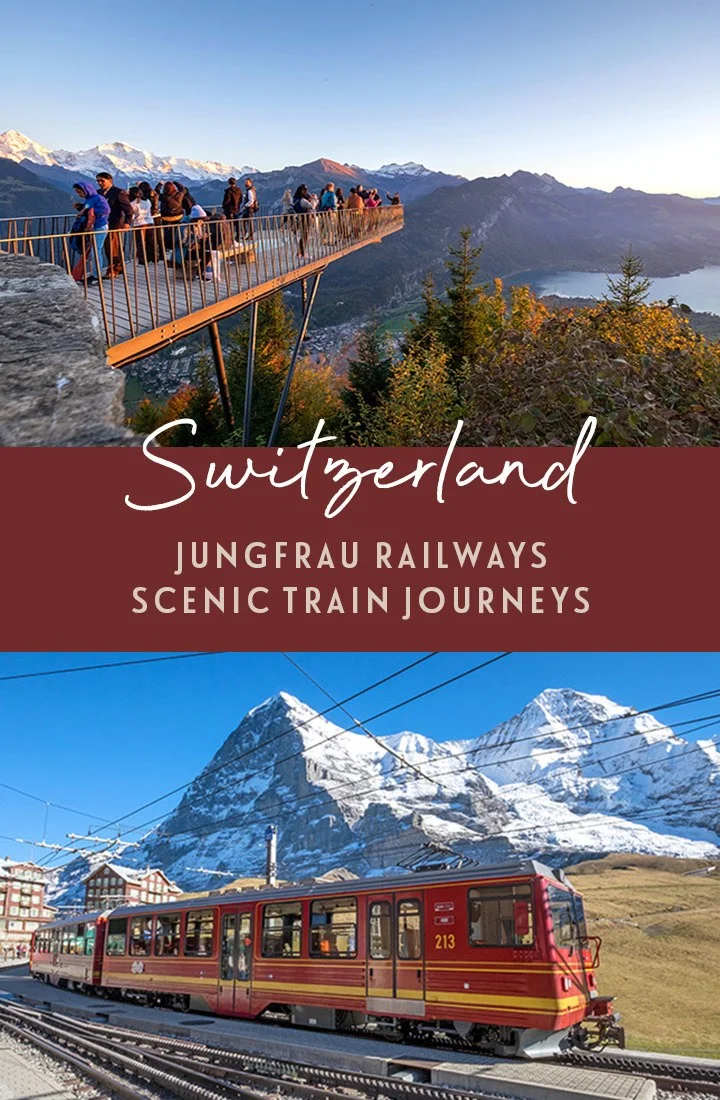
A lot of places boast breathtaking scenery, but my trip with Jungfrau Railways was the first time a view really took my breath away. As I looked around I could feel my head spin and my knees go weak. It might’ve been the bright blue skies and dazzling white snow, or the crisp, freezing mountain air, but then again it might’ve been the altitude. At 3454 metres above sea level, a trip to the top of the Jungfraujoch is enough to leave you breathless in more ways than one.
Read more: The Bernina and Glacier Express Swiss scenic trains
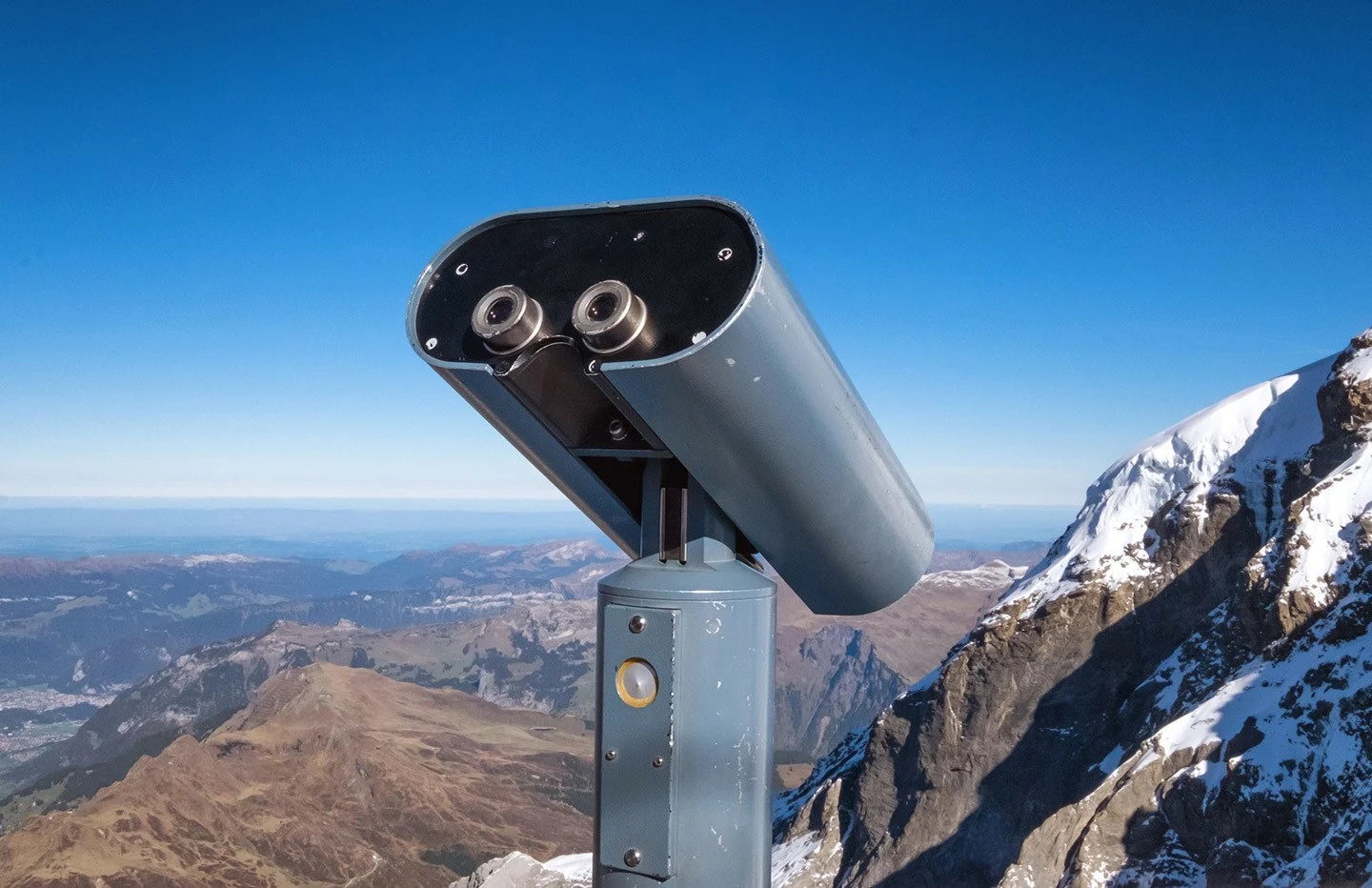
Jungfraujoch views
Europe’s highest railway station has views across the Swiss Alps and beyond into France, Germany and Italy. Up here you’re surrounded by the Eiger, Mönch and Jungfrau – peaks the world’s best mountaineers have tried – and sometimes lost their lives – trying to conquer.
But you don’t have to invest in an ice axe, climb for days and risk avalanches or frostbite to reach these heights today. Jungfrau Railways make these mountains accessible, and opens up this stunning high-altitude world to us less adventurous (or should that be less crazy?) types. And this isn’t the only mountain railway in the area either. There are a whole series of spectacular journeys that take you into the mountains of Switzerland’s Bernese Oberland.
This small area packs a major scenic punch with glaciers, alpine meadows, lakes and waterfalls. You can stay in Interlaken or the pretty mountain village of Grindelwald and try Jungfrau Railways’ mountain experiences. Trains, views, Swiss cheese – what more could you want?
Scenic Switzerland with Jungfrau Railways

Approaching the Eiger
Jungfraujoch: The high-altitude one
My first journey was on board the original Jungfrau Railway. Destination: the Top of Europe. The railway is an incredible piece of engineering, especially so when you think that construction started in 1896. It took 16 years to complete the 5.6-mile line, with most of it having to be tunneled through the rock of the Eiger and Mönch mountains.
It was a huge undertaking when so much work had to be done by hand. Our trip to the Jungfraujoch started in Grindelwald, where a local train makes the 30-minute journey past meadows, wooden chalets and pine forests to the tiny village of Kleine Scheidegg at the base of the Eiger. Another local train comes up from Lauterbrunnen too so there’s a choice of routes.
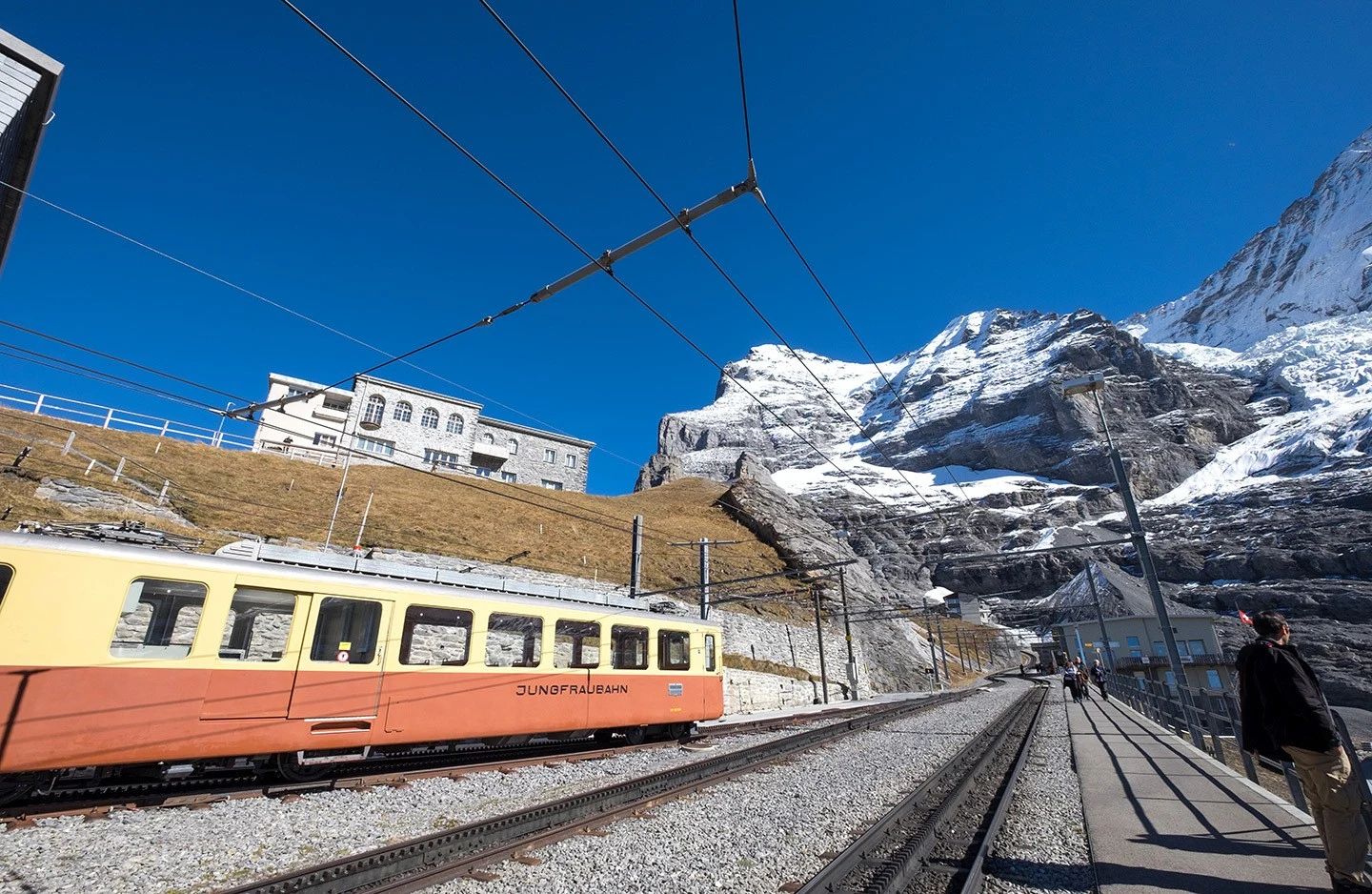
Stopping at Eigergletscher
From Kleine Scheidegg we boarded the Jungfrau Railways train to the Jungfraujoch, a narrow-gauge rack railway winding its way up 1500 metres. The first part of the line is open, with an avalanche shelter to protect the track from snowfall. Then at Eigergletscher you go into the tunnel through the rock. We made a quick stop at Eismeer, where windows have been cut into the rock so you can look out onto the glacier below and over to the Schreckhorn.
This is also where the rescue efforts for climbers who get into trouble on the Eiger’s North Face start from. I’ve been fascinated by this place since I read The White Spider, Heinrich Harrer’s book about his first ascent of the North Face in 1938. Altogether 64 people have died trying to reach the top, and looking at this 1800-metre sheer rock face from up close it seems impossible that anyone could possibly make it up there, but they did – and still do.
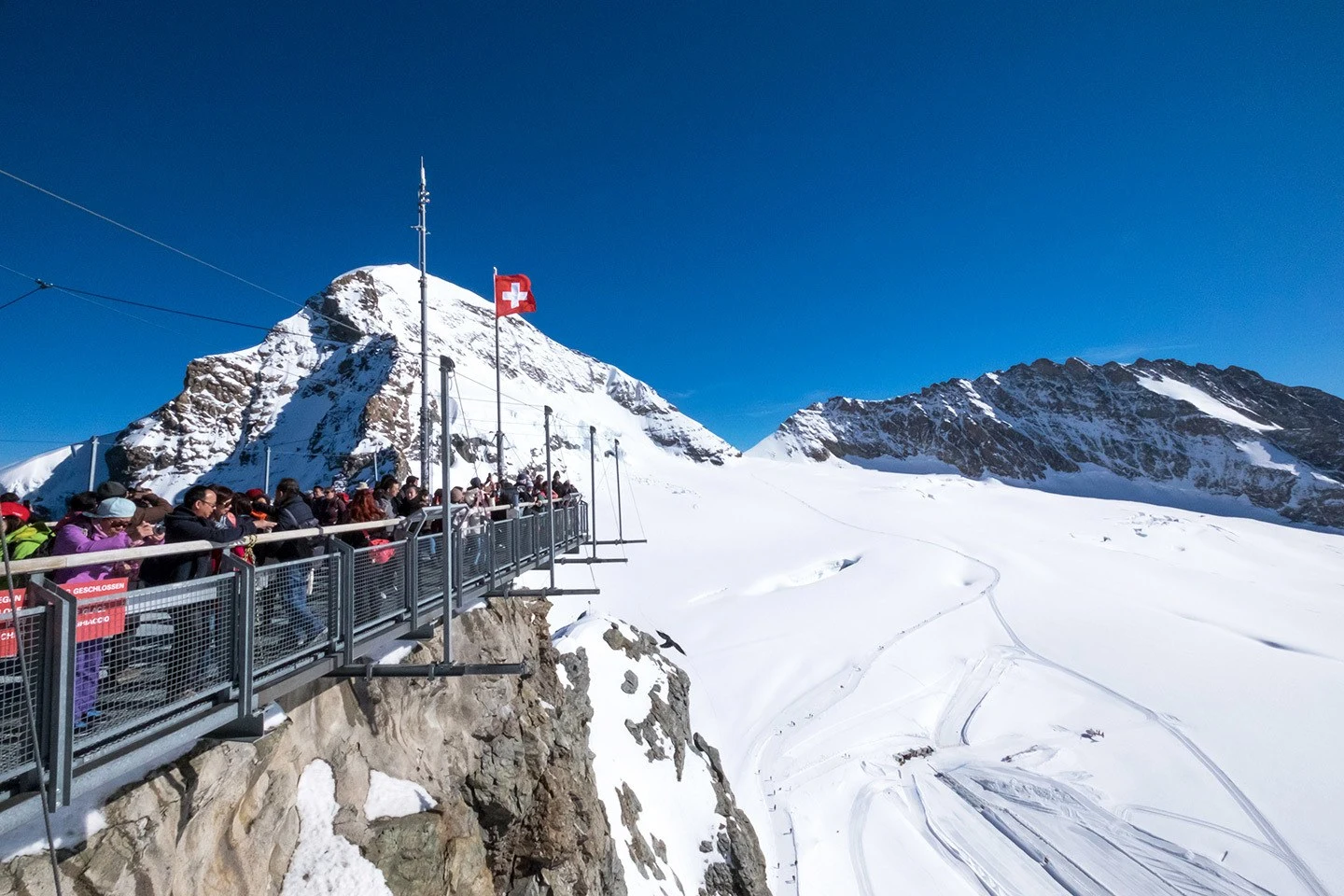
Looking out over the mountains
Back on the train, we carried on up the last stretch of tunnel to reach the Jungfraujoch. When you look at a cross section, it looks like a villain’s lair from a James Bond film. There’s futuristic-looking metal dome on the top of the mountain with a whole network of tunnels and buildings cut into the rock below. Except these are home to restaurants, a post office, chocolate shop and an ice palace, rather than a nuclear bunker and a swimming pool full of sharks.
But our first stop was the Sphinx viewpoint, because it’s the views that make this place so special. Jagged mountain peaks and an undulating carpet of pristine, unmarked snow as far as you can see. Though you need your sunglasses as the sun reflecting off 360° of snow is dazzling.

Definite Bond villain lair potential
It doesn’t matter what time of year you visit, it’s always winter at the Jungfraujoch. On a sunny autumn day, I was in jeans and a jumper down in Grindelwald but needed a coat and gloves at the top. The average temperature is -8 degrees, so even in the middle of summer you can go from swimming in the lake in Interlaken to throwing snowballs on the Jungfraujoch.
After a few minutes out in the open air at the top I started to get used to the altitude – until I started to walk anywhere. Even climbing up a tiny incline feels like you’re scaling a mountain peak when you’re up at 3454 metres. So there were less walks across the glacier and sledge rides and more time spent sitting on a deckchair in the sunshine soaking up the views.
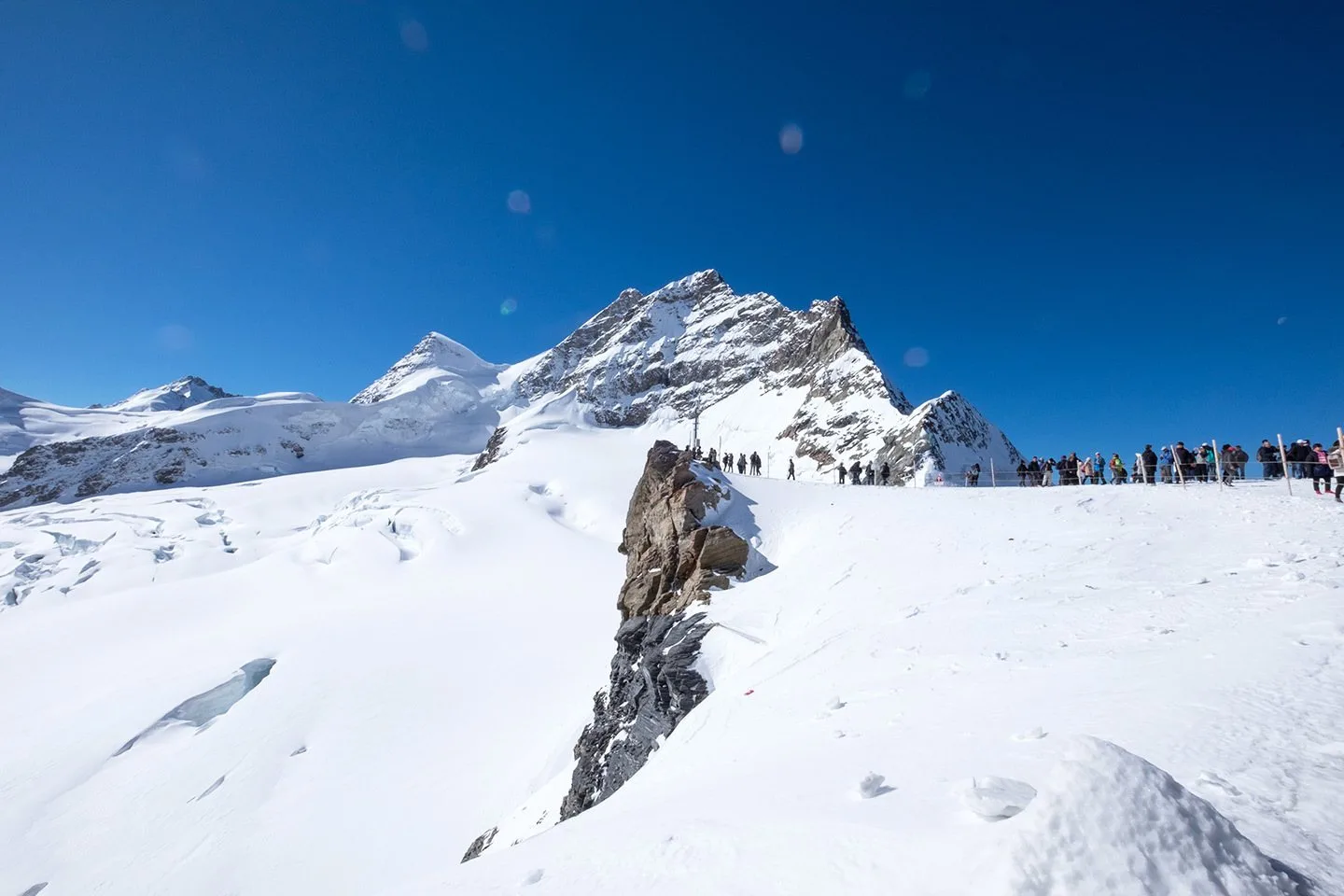
Out in the snow
There’s something about the mountains that just makes me want to get out and explore though. So on the way down we hopped off the train at Eigergletscher to walk part of the Eiger Trail back to Kleine Scheidegg. The 1000-metre drop in elevation from the top makes a huge difference and I immediately felt a burst of extra energy. The path is fairly gentle and takes you through Alpine meadows – which are extra pretty in spring when they’re full of wildflowers.
You can see down to Kleine Scheidegg and watch the trains make their way up and down. But as ever its the Eiger which dominates the landscape, from the Mittellegi mountain hut where climbers stopped to shelter on their way up to the perfectly flat lake reflecting it like a mirror.

Walking down to Kleine Scheidegg
Harder Kulm: The sunset one
If your idea of a good mountain view is one you can enjoy with dinner and a glass of wine, then Harder Kulm is the one for you. This funicular railway is just a few minutes walk from Interlaken Ost station, on the edge of the city. It’s another historic train route that’s been running since 1908 and was the quickest journey of the trip, taking just 10 minutes to climb up to 1332 metres.
The slope’s so steep that you almost feel like you’re travelling up vertically, with Interlaken stretching out below you. We reached the top to find a network of walking paths that lead to the Harder Kulm restaurant, which looks like a mountaintop castle from a fairy story. And out in front is the Two Lakes Bridge, a steel platform which is suspended in mid air.

Harder Kulm’s castle, sorry I mean restaurant
The platform gets its name from Lakes Thun and Brienz which you can see below you, as well as the miniature houses and roads of Interlaken and the peaks of the Eiger, Mönch and Jungfrau beyond them. I could even see the dome of the Jungfraujoch observatory way in the distance.
You can go up to the top of Harder Kulm during the daytime, but being up there for sunset made it extra special. Everything started to glow with the autumn leaves lit up in golden shades, before the sun dipped behind the mountains and the peaks turned pink. The last journey back down to Interlaken isn’t until 9.40pm so in autumn we had time to watch the sunset before drinks and dinner in the restaurant – and still get the train back to Grindelwald.
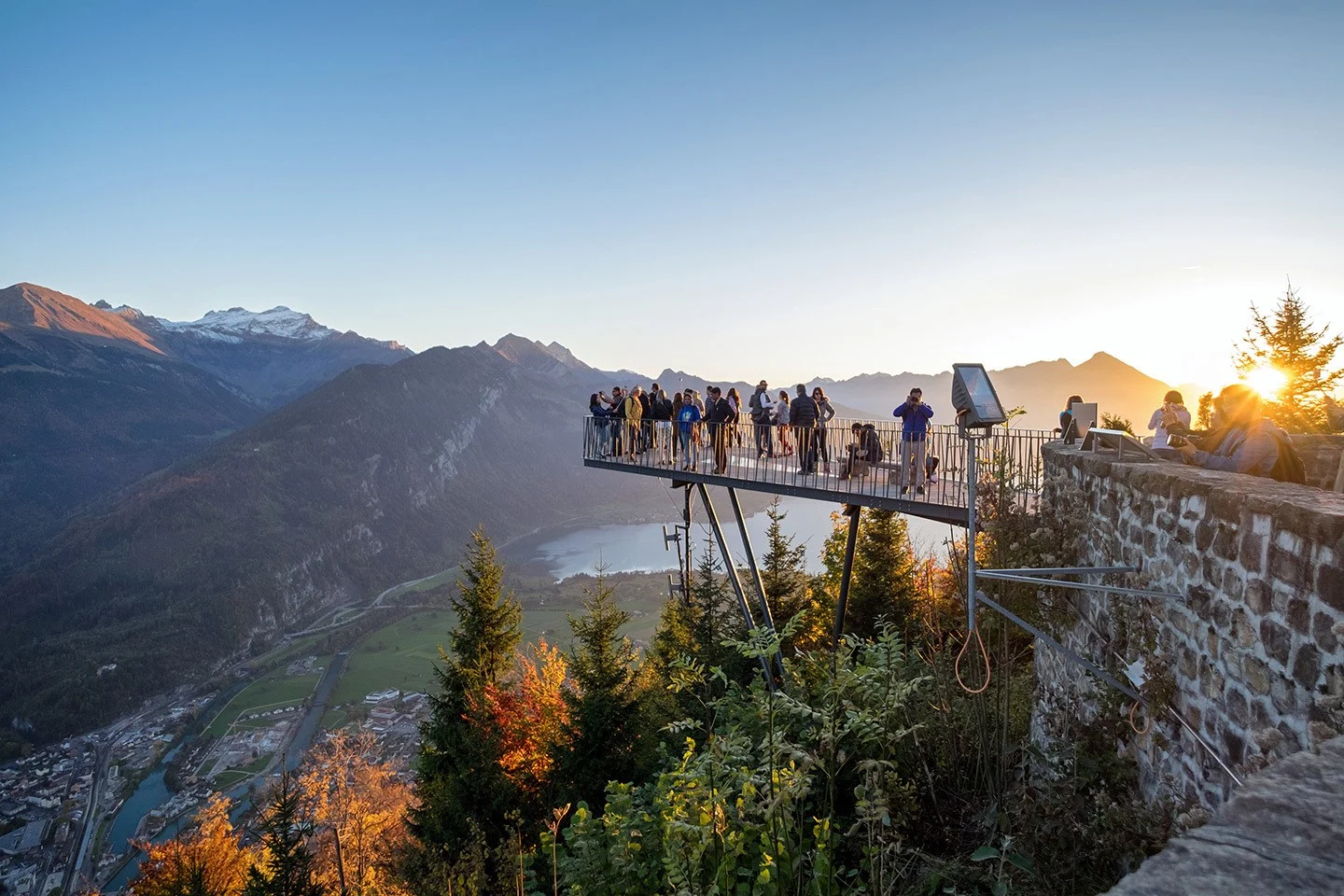
Views from the Two Lakes Bridge
Schynige Platte: The historic one
Our third Jungfrau Railways journey was a step back in time on the area’s oldest railway, which runs from Wilderswil just outside Interlaken to Schynige Platte. It zig-zags up through meadows and forests to 1967 metres above sea level, and has been running on the same route since 1893. The original rolling stock and railway line have been lovingly preserved – even the youngest train is over 100 years old, but you’d never be able to tell it from looking at her.
It takes 52 minutes to reach the top so you’ve got plenty of time to relax and enjoy the view. Or chat to your neighbours – we sat next to a local man who’d grown up nearby and travelled the world. But he’d never been to Schynige Platte until someone he met in India said it was the most beautiful place they’d been (glad it’s not just me who’s bad at exploring their own backyard).

Arriving at Schynige Platte
Schynige Platte is known for its hiking and yellow signposts point out the different routes. The path across the mountains to Grindelwald First is apparently one of Switzerland’s most beautiful hikes, but at six hours long we didn’t have time to try it out (though it’s good to have a reason to come back). Instead we followed the path through the Alpine Botanic Gardens – home to Swiss plants like gentian and edelweiss – and back along the ridge overlooking Interlaken.
On a gorgeous sunny day there can’t be many better places to be in the world. If you really want to get away from everything, there’s a mountain hotel up there too. It’s been there since before the railway was built and has no phones or TVs, all there is to do is relax and gaze out at those amazing views. Sounds pretty blissful to me.
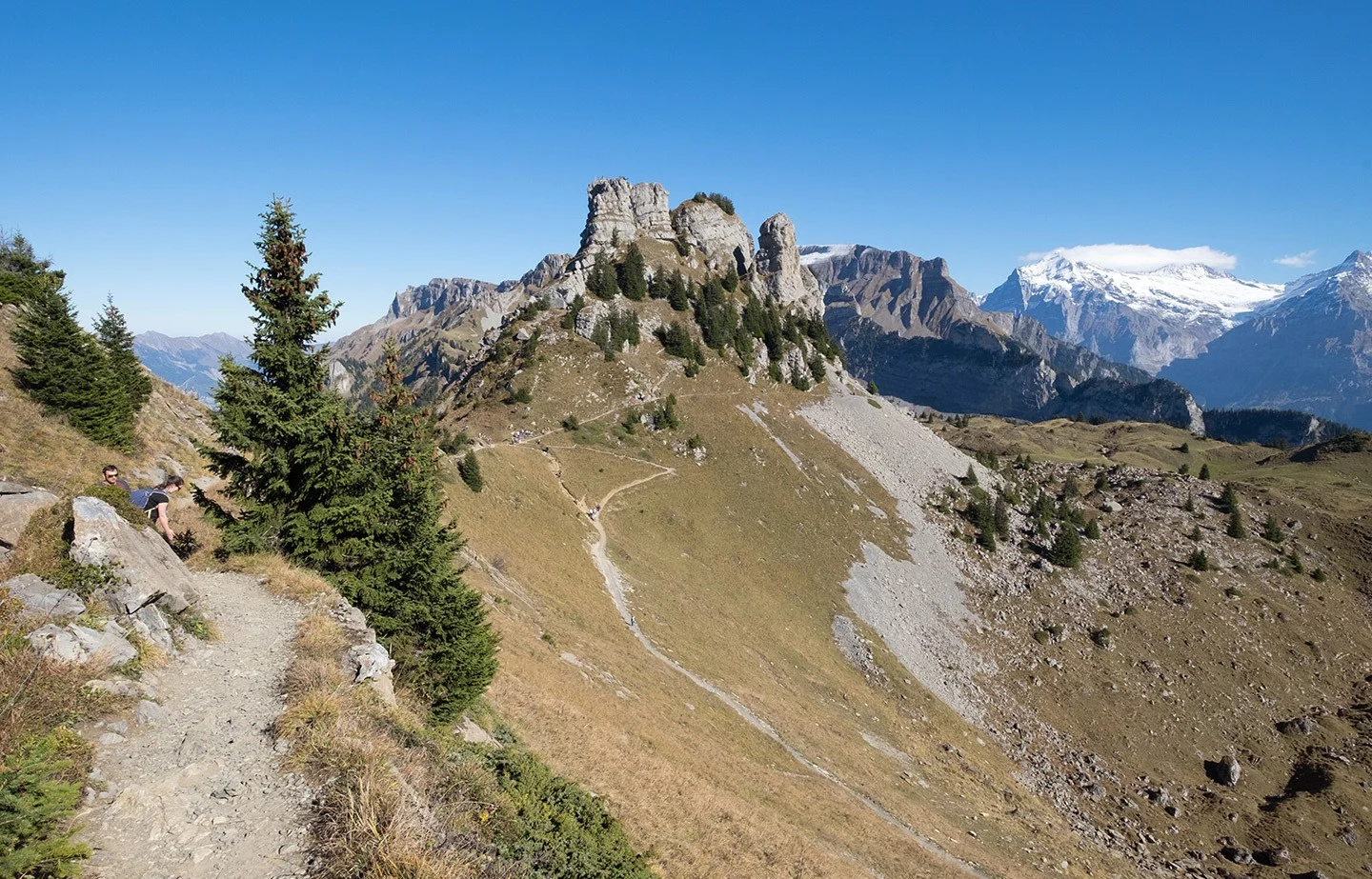
Hiking at Schynige Platte
Grindelwald First: The adrenalin-fuelled one
My final mountain journey was a bit different – the views were just as good, but this time I swapped the train for a cable car (and a wire!). On the slopes above Grindelwald, First is a ski area in the winter, but during the summer months it becomes an adrenalin-fuelled playground.
There’s a whole series of different adventures you can take part in, from high-speed to high-altitude, and from exciting to vaguely terrifying. First up was the First Cliff Walk. In theory this sounded like the most sedate option – a walkway along the cliff edge. But with single-rope hanging bridges, metal platforms bolted into the side of the cliff face and a glass-floored platform hanging over a precipice I found myself tightly gripping the handrail.

The First Cliff Walk
After warming up my head for heights, next we took to the skies on the First Flyer, a zip line shooting 800 metres downhill at 84 kilometres per hour. After being strapped in, four of us sped down together, and once I got over the initial “oh god I’m 50 metres up” moment the views and speed totally distracted me. Ever resourceful, the Swiss guy manning the zip line even strapped our guide in with the bags of packed lunch so he didn’t have to miss out.
With the adrenaline flowing, next up was the hang-glider style First Glider. We were kitted up with body suits, attached to a metal eagle-headed frame, and pulled 800 metres backwards uphill in a kind of a reverse zip line before swooping back down. Back on the ground, we finished by speeding downhill on the First Mountain Cart, a go kart/sledge combo that bumped over rocky paths and squealed around corners as I just managed to stay upright.

On the edge and taking flight
From the Top of Europe to the bottom of the hill on a mountain kart, what I really liked about the Jungfrau Railways was how accessible they make the Swiss Alps. This area has some of the most gorgeous scenery in the world and to be able to get out among it and hike, bike, fly or just sit on a bench and look out over those peaks, means that everyone can enjoy the Jungfrau region’s mountain views, whatever their age or fitness level.

A bench with a view
The details
The Jungfrau Railways Travel Pass gives you unlimited train travel through the area over three to eight days (excluding the train to the Jungfraujoch which is half price). Passes for five days or more also include boat trips on Lakes Thun and Brienz. Passes cost 190–310 CHF (€180–€290) – plus 61 CHF (€58) for the Jungfraujoch train – with discounts for Swiss Rail Pass holders.
The Jungfrau Railway is open all year but the others close for the winter (Harder Kulm from Dec–mid April and Schynige Platte from Nov–June). The activities at Gridelwald First run from May–Nov, with a combined Adventure Card for 120 CHF/€112 if you want to try them all.
We flew to Zurich with Swiss Airlines and took the train to Gridelwald. We stayed at the Romantik Hotel Schweizerhof in Grindelwald, a five-star traditional Swiss hotel with spa, pool and restaurant. Double/twin rooms start from £245 per night half-board.
Pin it
Many thanks to Jungfrau Railways for hosting me. All views and opinions are, as always, my own. This article contains affiliate links, where I get a small commission at no extra cost to you, thanks.


